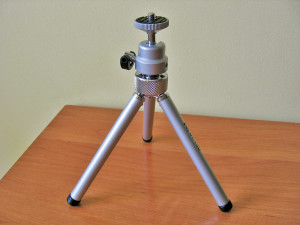Creating a Low-Budget Studio
Digital Mineral Photography: Creating a Low-Budget Studio
While it is important to create a catalogue or digital record of your fine rocks and minerals, for those with an extensive collection, the cost of professional photography can be significant. Luckily, the progression of digital technology has made mineral photography more accessible to the everyday collector, and these days, even the most novice photographer can capture clear and attractive images of their most prized specimens.
With a small investment in equipment, and just a little time and effort, you can create your own amateur mineral photography studio, and use it to produce a beautiful digital display of your fine rocks and minerals. We’ve outlined the basics, below – for your convenience!

- The Digital Camera (With Tri-Pod). It goes without saying that if you’d like to enter the world of digital mineral photography, you’ll need a camera which takes digital images. These days, even a recent-model iPhone is capable of snapping some pretty great images – but it is important, for your purposes, that you ensure your camera of choice includes a few key features. You’ll want it to be capable of taking images with or without flash, have a USB port for easy image syncing, and have enough memory to hold at least 200 images on the highest resolution.
We also strongly advise purchasing a model with macro-imaging capabilities, or a compatible macro lens, to improve the quality of your close-up shots. And, you’ll definitely want to purchase a tri-pod – an absolute necessity for attaining clear, hands-free shots. - The Studio Backdrop. Simple plywood or MDF can be used to create a completely customized, three-sided studio backdrop – or, you can repurpose a pre-existing base, such as a sturdy wine box or even an old drawer. Feel free to get creative, as the base material will be completely hidden from view.Once you’ve chosen your base, use a staple gun or hot glue to cover it in fabric. Remember – the best backdrops are those which are unobtrusive, and highlight the natural beauty of your specimen. We’ve found that non-reflective fabric (such as velvet or cotton ducking) in shades dark blue or black are best. If you’d like to lend extra visual appeal to your mineral photography set-up, have your local hardware store cut a glass pane to fit your display base. Placing this between your specimen and the fabric background can add additional depth and reflect to your images – a nice touch!
- Effective Lighting. The use of two cheap, positionable office lamps is essential, and will help you light your mineral photography studio effectively. Use low-wattage, fluorescent “daylight” bulbs to avoid flaring effects (which arise from overlighting), and to achieve the most realistic and true-to-life colors.For best results, position one lamp to light the specimen from above, and one to the side, to provide shading and depth. You’ll need to experiment with the exact positioning required to highlight the best features of each specimen, but using adjustable lamps will make this a snap. It may also be helpful to use a dab of mounting putty beneath your rock and mineral specimens, to allow greater control of positioning.
- Editing Software. Even those who are experts at mineral photography require the use of an editing software to crop, frame, and color-correct their images. But before you break the bank on a purchase of a professional-grade program, we recommend checking out this article, which provides a detailed description and review of several photo-editing softwares which are available for download online – for free – and save your budget for future collecting!
Still interested in creating an attractive digital catalogue of your collection, but not sure you’re ready to take on the challenges of fine rock and mineral photography? Contact the experts at iRocks, and we’ll help you decide if professional photography is the right choice for your collection!